I had some advice for her, primarily some principles she could look to incorporate into her boards as she moves forward, that I think will really help take her sequences to the next level. She was kind enough to allow me to post my notes here, so that others could benefit and learn from her work!
To illustrate the principles and techniques, I took a single panel from her sequence and drew over it. I gradually built up a new panel using hers as a starting point.
(The entire sequence can be seen on her blog, however for the sake of clarity I chose to focus on one panel.)
1. ORIGINAL PANEL FROM HAN'S SEQUENCE:
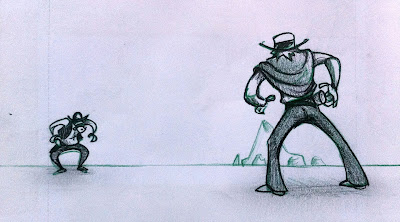 Conceptually, it is a good.
Conceptually, it is a good. -She has clearly established a screen relationship between two characters (left and right).
-Indicated an envirment (the mountain range in the background)
-Suggested a certain degree of depth.
My main note, push it! push it good! Push the depth! Push the background! Take the concept of this shot and push it to find a more interesting and compelling compostition.
2. DRAW YOUR GRIDS!
I started my redraw with a horizon line and laying down a grid.
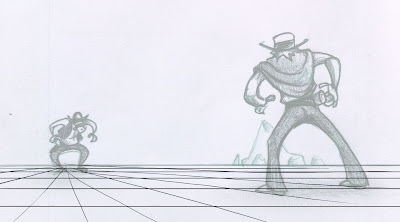 Laying down your grid is something that's been pounded into my head by almost every feature board artist I've ever worked with. It'll help clarify your depth, and can be used as a guide for incorporating mid/forground elements (illustrated in Step 5.)
Laying down your grid is something that's been pounded into my head by almost every feature board artist I've ever worked with. It'll help clarify your depth, and can be used as a guide for incorporating mid/forground elements (illustrated in Step 5.)Trust me, lay down your grids, it'll help!
3. PUSH THE DEPTH
In her original panel, there is a lot of empty space around the characters, not particularly interesting visually. I drew over the characters, using my grid as a guide, and tried to push the depth.
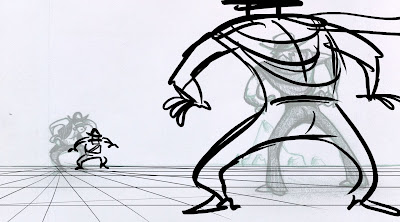 By pushing the depth, bringing one character closer and pushing one further away, you can create a much more engaging composition, as well as utlizing the real estate of the panel more effectively.
By pushing the depth, bringing one character closer and pushing one further away, you can create a much more engaging composition, as well as utlizing the real estate of the panel more effectively.4. USE THE BACKGROUND TO ENHANCE THE COMPOSITION
You can use background elements to enhance a composition and direct the eye.
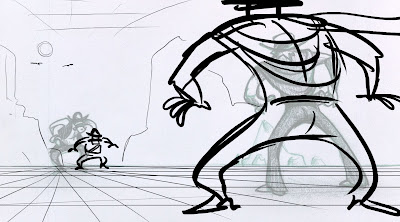 The important information in the above panel is the charatcers, so everything else in the composition should support that. Keeping that in mind, we can use mountain ranges in the background to help lead the eye to the character.
The important information in the above panel is the charatcers, so everything else in the composition should support that. Keeping that in mind, we can use mountain ranges in the background to help lead the eye to the character.5. POPULATE THE MID-GROUND
Put some junk in the mid-ground.
 Populating the mid-ground can help in a few ways:
Populating the mid-ground can help in a few ways:-Further help define the enviroment
-Help push the depth by incorporating over-lapping elements as well as visual depth cues (things getting smaller as they recede)
6. A LITTLE SHADING GOES A LONG WAY
In the original panel the shading was a bit too detailed yet oddly unspecific. You can simplify the shading by thinking about it in terms of foreground, midground and background.
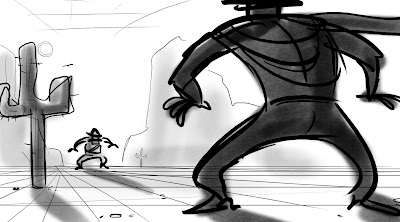 I did a quick shade pass over the panel using each object's relative position in the composition, how close/far away it is from us, and shaded accordingly.
I did a quick shade pass over the panel using each object's relative position in the composition, how close/far away it is from us, and shaded accordingly.We can also use shadows to help direct the eye (just like the background) by having them point towards other important information.
Below is a gif of the progression so you can see how being concious of these principles while your boarding can really help enhance your work. UPDATE:(You may need to click on it to see it animate)
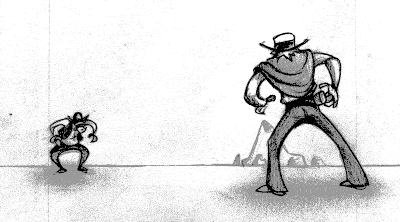 With storyboarding it is just a matter of getting sequences under your belt, the more you board, the better you get, plain and simple. Don't be discouraged if you don't see immediate improvement. It takes time for these principles to become second nature, the most important thing is that you are aware of them and how they can affect your work.
With storyboarding it is just a matter of getting sequences under your belt, the more you board, the better you get, plain and simple. Don't be discouraged if you don't see immediate improvement. It takes time for these principles to become second nature, the most important thing is that you are aware of them and how they can affect your work.Han is off to an amazing start, I can't wait to see where she goes from here!
A big thanks to Han for allowing me to post this here. If you've taken anything away from this little break down, please visit Han's blog and thank her! It wouldn't have been possible without her hard work and generosity.
-Hat
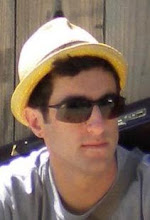
9 comments:
Hey Hat!
Cheers big time for your advice - really awesome! Will definitely take it on board and feel sooooooooooo honoured that you would take the time to give me the feedback. Being tucked away down here in NZ I'm often a little jealous of the opportunities that American animation students must get to receive input from epic people in animation who have worked for the big studios we all aspire to work at. So yay for the internet for giving me a similar experience!
Any other advice at any time is incredibly welcome. : ) And that goes out to everyone else too. : )
Thanks again!
Lucky girl! This is an awesome post. Thank you.
This is amazing! Thanks so much for the wonderful information! Us young artists are really lucky that the internet blesses us with experienced professionals willing to turn us into cartoon masterminds.
amazing notes and it did help us to know this basics on storyboard which helps also while laying down Animation sequences and shots :)
This is great! I love posts like this! And kudos to Han..these are worlds better than my first attempts at storyboarding :)
Are you kidding Megan?! Coz your storyboards are also so amazingly epic! : )
Well if I keep practicing and with awesome advice like this, hopefully I can enter the realm of you guys. : ) ooh the pressure. haha
Hat, I'm learning a lot with your storyboard adevices! I'm sharing your tips with my workmates!
Your are right about drawing grids, it helps a lot, so, I'm trying to draw it as much as I can!
I'm so glad to see you are improving your skills day by day and I wish you all the best!
Keep working hard!
Freaking fantastic !! Thanks !
Keep the storyboarding tips coming, they are really helpful !
Post a Comment